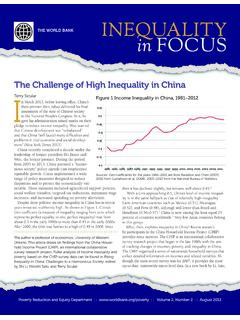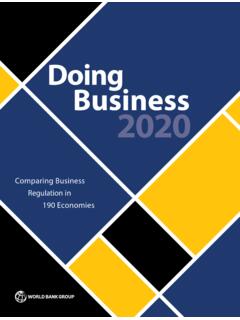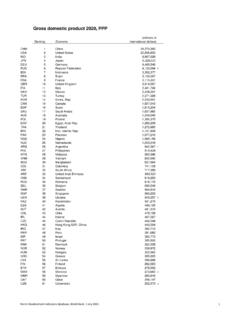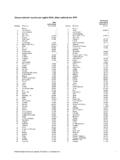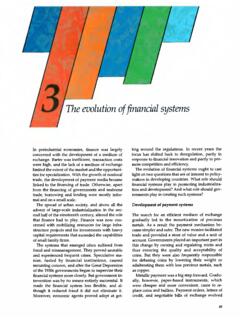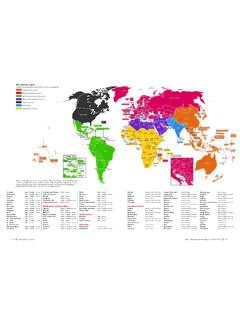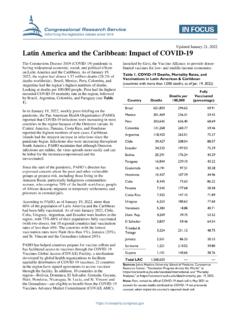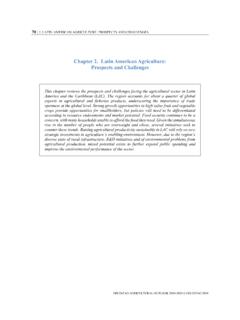Transcription of 2 THE UNBANKED - World Bank
1 | 352 THE UNBANKEDG lobally, about billion adults remain UNBANKED without an account at a financial institution or through a mobile money provider. In 2014 that number was 2 account ownership is nearly universal in high-income economies, virtu-ally all UNBANKED adults live in developing economies. China and India, despite having relatively high account ownership, claim large shares of the global UNBANKED population because of their sheer size. Home to 225 million adults without an account, China has the World s largest UNBANKED population, fol-lowed by India (190 million), Pakistan (100 million), and Indonesia (95 million) (map ). Indeed, these four economies, together with three others Nigeria, Mexico, and Bangladesh are home to nearly half the World s UNBANKED popula-tion (figure ).M A P 2 .1 Globally, billion adults lack an accountAdults without an account, 20171 million10 million100 million200 millionSource: Global Findex : Data are not displayed for economies where the share of adults without an account is 5 percent or | FINDEX 2017 Who the UNBANKED areWomen are overrepresented among the World s UNBANKED .
2 About 980 million do not have an account, 56 percent of all UNBANKED adults globally (figure ).Women are also overrepresented among the UNBANKED in most economies. This is true even in economies that have successfully increased account ownership and have a relatively small share of adults who are UNBANKED . In Kenya, where only about a fifth of adults are UNBANKED , about two-thirds of them are women (figure ). Women make up nearly 60 percent of UNBANKED adults in China and India and an even higher share in Turkey. Things are not much different in economies where half or more of adults remain UNBANKED : in Bangladesh 65 per-cent of UNBANKED adults are women, and in Colombia 56 percent without an account, men as well as women, tend to be concentrated among poorer households. Globally, about a quarter of UNBANKED adults live in the poor-est 20 percent of households within their economy, about twice the share living in the richest 20 percent (figure ).
3 Sorting households within each economy into just two groups the poorest 40 percent and the richest 60 percent provides another perspective. World -wide, half of UNBANKED adults come from the poorest 40 percent of households within their economy, while the other half live in the richest 60 percent. This global pattern is replicated in many economies where half or more of adults are UNBANKED , such as Colombia, Ethiopia, Indonesia, and Nigeria. In these econo-mies UNBANKED adults are just as likely to come from poorer households as from wealthier in economies that have expanded account ownership to two-thirds or more of adults, poor adults are more overrepresented among the UNBANKED (fig-ure ). In China, for example, where about a fifth of all adults are UNBANKED , F I G U R E 2 .1 Nearly half of all UNBANKED adults live in just seven economiesAdults without an account by economy (%), 2017 BangladeshMexicoIndiaIndonesiaChinaPakis tanRest of World Nigeria54131166433 Source: Global Findex UNBANKED | 37 FIGURE , most UNBANKED adults are womenAdults without an account by gender (%), 20174456 WomenMenSource: Global Findex are overrepresented among the UNBANKED in most economiesAdults without an account (%), 2017 PakistanNigeriaIndonesiaEthiopiaColombia BangladeshTurkeyKenyaIndiaChinaBrazilWom en Men020406080 Economies with half or more of adults unbankedEconomies with a third or less of adults unbankedSource: Global Findex as many UNBANKED adults live in the poorest households in their economy as in the richest onesAdults without an account by within-economy income quintile (%), 2017Q1:27Q2:23Q3:20Q4: 17Q5: 13 PoorestRichestSource.
4 Global Findex economies where a small share of adults remain UNBANKED , most of the UNBANKED are poorAdults without an account (%), 2017 PakistanNigeriaIndonesiaEthiopiaColombia BangladeshTurkeyKenyaIndiaChinaBrazilPoo rest 40% Richest 60%of households of households020406080 Economies with half or more of adults unbankedEconomies with a third or less of adults unbankedSource: Global Findex | FINDEX 201765 percent of this group belongs to the poorest 40 percent of households. In Brazil, where a little less than a third of adults are UNBANKED , 58 per-cent of these adults live in the poorest 40 percent of adults are disproportionately young. Globa l ly, 30 percent of UNBANKED adults are between 15 and 24 years old (figure ).1 Among all adults in developing economies, only 23 per-cent fall in that age group. The UNBANKED pop-ulation is even younger in economies where the share of UNBANKED adults is relatively small.
5 In Brazil, India, and Kenya about 4 in 10 UNBANKED adults are in the age group 15 adults tend to have low educational attainment. Globally, 62 percent of the UNBANKED have a primary education or less, compared with about half of adults overall in developing economies. This share is even higher in some economies, such as Ethiopia, where 92 percent of UNBANKED adults have a primary education or less as well as Tanzania (86 percent) and Pakistan (75 percent). Worldwide, only 38 percent of the UNBANKED have completed high school or postsecondary edu-cation (figure ).A slight majority of UNBANKED adults are either employed or seeking work. Yet compared with other adults, those who are UNBANKED are more likely to be out of the labor force. Among all adults in developing economies, 37 percent are out of the labor force. Among UNBANKED adults, that share is 10 percentage points higher (figure ).
6 FIGURE UNBANKED adults have a primary education or lessAdults without an account by educational attainment (%), 20173862 Primary educationor lessHigh school orpostsecondarySource: Global Findex in 10 UNBANKED adults are between the ages of 15 and 24 Adults without an account by age group (%), 20177030 Ages 15 24 Age 25+Source: Global Findex half of UNBANKED adults are out of the labor forceAdults without an account by labor force participation (%), 20175347 Out of labor forceEmployed orseeking workSources: Global Findex database; Gallup World Poll UNBANKED | 39 These global numbers obscure gender inequal-ity in labor force participation among UNBANKED adults. The majority of UNBANKED men 68 percent are employed or seeking work. For UNBANKED women the picture is flipped: 59 percent are out of the labor force altogether (fig u re 2.)
7 9).Among UNBANKED adults who are economically active, self- employment is the most common form of work. Indeed, more than a quarter of all UNBANKED adults reported being self-employed, while less than a fifth reported working for wages (figure ). The reverse is true for adults overall in the developing World : the share work-ing for wages, at 31 percent, is slightly larger than the share who are people remain unbankedGloba l ly, 31 percent of adults are UNBANKED . To help shed light on the reasons for this, the 2017 Global Findex survey asked adults without an account at a finan-cial institution why they do not have one. Respondents could offer more than one reason, and most gave most commonly cited barrier was lack of enough money. Nearly two-thirds of adults without an account at a financial institution said that they have too little money to use one, and roughly one in five cited this as their sole reason FIGURE the UNBANKED , women are less likely than men to participate in the labor forceAdults without an account by gender and labor force participation (%), 20174159 MENWOMENOut of labor forceEmployed orseeking work6832 Out of labor forceEmployed orseeking workSources: Global Findex database; Gallup World Poll I G U R E 2.
8 10 Self-employment is the most common form of work for UNBANKED adultsAdults without an account by employment status (%), 201747 Out of labor force6 Unemployed28 Self-employed18In wageemploymentSources: Global Findex database; Gallup World Poll | FINDEX 2017for not having one (figure ). No other rea-son was cited as the sole barrier by more than 5 , 30 percent of adults without an account at a financial institution said that they do not need one, making this the second most com-mon reason cited. Yet only 3 percent cited it as their only reason for not having an account. This suggests that among those reporting lack of need as one of several reasons, some might be open to using financial services if the services are acces-sible and relevant to their is another important barrier, cited by 26 percent of adults without an account at a financial institution.
9 But the share reporting that accounts are too expensive was twice as high in latin America and the Caribbean. In Brazil, Colombia, and Peru almost 60 percent cited cost as a similar global share, 26 percent, said that they do not have an account because a family member already has one. In some economies women were more likely than men to cite this reason. Among those without an account in Turkey, 72 per-cent of women mentioned this reason, while 51 percent of men did. In China the share for women was 35 percent, and for men 27 is a barrier for many: 22 percent of adults without an account said that financial institutions are too far away. In some economies the share was higher, with about 33 percent citing distance as a barrier in Brazil, Indonesia , and Kenya and 41 percent doing so in the requirements also hamper account ownership. Twenty per-cent of adults without an account at a financial institution reported lacking the documentation needed to open one.
10 Higher shares cited this barrier in such economies as Zambia (35 percent), the Philippines (45 percent), and Zimbabwe (49 percent).Distrust in the financial system features as a greater barrier in some regions than in others. Globally, 16 percent of adults without an account at a financial institu-tion cited this barrier but the share was more than twice as high in Europe and Central Asia and in latin America and the only 6 percent of adults without an account at a financial institution cited religious concerns as a reason, the share was substantially higher in some F I G U R E 2 .11 Lack of enough money is the most commonly cited barrier to account ownershipAdults without a financial institution account reporting barrier as a reason for not having one (%), 2017020406080 Religious reasonsLack of trustLack of necessarydocumentationFinancial institutionstoo far awayFamily member alreadyhas an accountAccounts too expensiveDo not need an accountNot enough moneyCited as sole reason Cited with other reasonsSource: Global Findex : r espondents could choose more than one UNBANKED | 41economies with a predominantly Muslim population.

